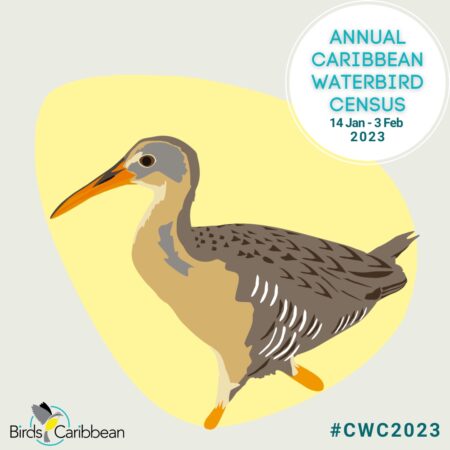
This year we have featured seven waterbirds in our Caribbean Water Census graphic! Find out more about each of these beautiful birds in our blog posts and on social media.
It’s January, which can only mean… the Caribbean Waterbird Census (CWC) is back! Get ready with us for the CWC2023 and meet this year’s featured waterbirds. First up is a bird you’re most likely to hear before you see it— the Clapper Rail.
The Clapper Rail is one of our larger rails. Their coloration varies across the geographical range, but in the Caribbean they are a dull buffy-cinnamon overall with gray on the face. They have pale-orange down-curved bills. Clapper rails rarely fly, spending most of its time on the ground concealed by dense vegetation, typically mangroves. This makes them hard to spot! You will need to listen for its call which can be a short series of clacking “cac-cac-cac” or grunting notes.
If you’re lucky, you may be able to see it boldly stalking prey like small crabs, aquatic insects, and small fishes, twitching its short tail as it walks, or swimming across a tributary. Although large bodied and abundant across its range, along the Atlantic and Gulf coasts of the United States, and also in the Yucatan and Caribbean, its secretive habits mean its biology remains somewhat a mystery.
Marshes and mangroves are important areas for the Clapper Rail and although not a species of conservation concern, habitat modification can hamper successful nesting. Draining for example causes low marsh plants to be replaced by high marsh or terrestrial plants reducing availability of suitable nesting sites for this rail.
If you see any Clapper Rails on your #CWC2023 counts this year, don’t forget to tag us @birdscaribbean and share your amazing photos!
CWC 2023 starts on Saturday January 14th and runs to Saturday February 4th. See below for detailed instructions and free downloadable resources to help you make the most of your waterbird counts and don’t forget to keep an eye out for Piping Plovers!






